#that have unique adaptations or mimicry or anything of the like
Explore tagged Tumblr posts
Note
I've been reading foxfall off and on for like, the past month?? And I'm really invested, completely brainrotted, can I pretty please have more world building on the whole humans are pokemon thing? I have honestly never seen anything like it
well, starting with the assumption that "pokemon" is basically the world's version of "animal", it would make less and less sense for humans to not simply be a one-stage pokemon. from there, it was a simple narrowing down of what a human's type would be and what would make them mechanically strange.
based on what humans can do in the games and show, psychic made the most sense, and normal- because why would the move type be "normal" if humans didn't see it as default somehow?
humans just As A Thing are very intelligent and highly adaptable in the real life with a high mimicry capacity, and it seems that humans have a largely unique ability to domesticate/cohabitate with literally any other pokemon. so it made sense (to me specifically), if humans had a level of psychic communion/compulsion and a really REALLY broad moveset, albeit one only unlocked by the power of friendship. to an extent, it's possible egg moves may also be real, since things like advanced psychic powers can run in families.
a side note- the reason you get four move options in pokemon battles, in-universe, is because humans can only hold on to four moves at a time, and so use it as a sporting standard. the actual pokemon themselves could know more moves for work, tricks, or their own use, but the rule of the sport is four.
beyond the sygna move they can aquire from their pokemon partners, the rest of their moveset is usually a normal type non-combat move or a support move. people who have a moveset full of attack moves or self-harming ones is a sign of something kind of being psychologically fucked. someone's inherent Ability also says something about them occupationally or psychologically. moves and abilities are acquired and changed over time- what does it say something about a person to have the moveset they do?
the human niche, for foxfall purposes, boils down to the capacity to get along with anyone and make anyone get along with each other. from the ground up, human civilization and society is intertwined with the integration of pokemon. though in the time period foxfall takes place, they haven't yet figured out that they can do this to EVERY pokemon, so some are still seen as too dangerous/taboo to be safe.
26 notes
·
View notes
Text
Ant-mimicking spider inspired powers
- ꜰᴏʀ ꜱᴘɪᴅᴇʀ-ᴠᴇʀꜱᴇ ꜱʜɪꜰᴛᴇʀꜱ


Ant-mimicking spiders (Myrmarachne spp. and others) are small arachnids that look and move like ants. They have long, slender bodies and often hold their front legs up like antennae to blend in perfectly with ants. Their unique appearance and behavior make them masterful imitators, using their disguise for protection and to catch prey.

Total mimicry - User can mimic and replicate absolutely anything and everything that others are, can do or have.
Adoptive muscle memory - The user can copy any/all movements/actions after observing it performed once, including acrobatics, martial arts, and other physical stunts.
Web generation - The power to create webs out of various kinds of substances/forces.
Silk constructs -> Safety lines - Jumping spiders anchor themselves with silk lines when leaping, ensuring they can climb back to safety.
Venomous fangs - The user possesses teeth that are coated with or secrete natural venom, which can extend to the victim when said victim is bitten by the fangs - the poison paralyses the victim
Pheromone generation - The user can secrete powerful pheromones that have a variety of effects on others + they can mimic the pheromones of the the people they imitate (idk)
Hunting mastery - The power to possess extraordinary mastery, talent and instinct for hunting all things.
Spider sense - The user can sense nearing danger, acute danger, potential immediate danger, or impending danger and sense unwanted or hectic threats to their well-being and the possibility to evade it.
Enchanted eyesight - The power to possess a sense of sight beyond that of the peak members of their species.
Enchanted durability - Users possess physical durability far exceeding that of peak members of their species.

Traits inspired by the ant-mimicking spider
Brown, black or red for suit/hair/eyes
Medium height
Aggressive
Adaptable diet
Energy efficiency
Daytime activity
Adaptive learning, social interaction mimicry, bold risk taking...
Spider powers masterlist | Masterlist

#luna's spiders#luna's power lists#desired reality#shiftblr#reality shifting#shifting community#reality shift#shifting#shifting realities
7 notes
·
View notes
Text
Undead Girl Murder Farce Episode 1: Oni Slayer

What do you get when you cross an incredibly weird manga with the director/creative visionary behind the Love Is War anime adaptation? Well, if the answer wasn't obvious, you get something incredibly creative, weird, and cool. Lapin Track might not be a studio people really know the name of, but between the creator of this story, and the director of this anime, they certainly want to leave a lasting impression on anybody that takes a chance with this story. And they've absolutely left me with a mountain of stuff to talk about.
The short of it though? Watch this show, right now if you haven't already.
Where to even begin? I think the introduction of the setting for the world is a little low effort, but I do really like the direction of the actual pieces between it. There's an incredible amount of creative and incredibly unique cuts right from the start that lets viewers know they're in for a ride. Just take a look at this blink-and-you'll-miss-it moment.
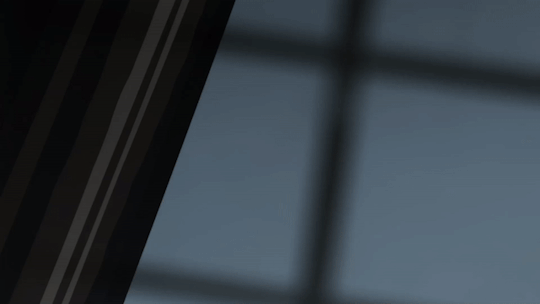
But yeah, Undead Girl Murder Farce takes very little time to live up to its name, both in terms of visuals and story, as we follow around our hybrid Oni lead character Tsugaru. Right away, his character grabs you with his over the top but equally lax nature that's all about showing off and having some fun.
Of course, his character isn't purely fun and lazy, there's a deeper past to him as well, and they showcase that very early on through his vice of drinking. Very effective and simple, it doesn't try to claw anything out of viewers, but rather add just a bit of an explanation to his character. And of course, it does it in style, mirroring the focus on each limb in the present vs his past before bringing him back to reality.

If I were to choose a single theme for this episode, it would be parallel. A monster in a cage, a human on the streets, past and present blurring, harmless creature vs foul beast. An act, or a farce? The entirety of it is mimicry and dichotomies, like Tsugaru mimicking this cat that he protects from a random crowd. And it's incredibly well done.

Alright, I've got to speed this along or I'm going to be here all day. It's good, it's great, it's bold, so on and so forth. What's next? Well, this cool ass fight, of course. Yeah, Lapin Track providing not only good animation, but impressive, creative, and in character direction for a fight scene? I was really just sitting watching this episode with my jaw hanging loose (though this is now my third time through the episode).
There's really not much else to say. The fighting styles and approaches are perfectly in tune with the characters and their thoughts in the moment. They make full use of their surroundings and the tools at their disposal, and you can absolutely tell that Tsugaru is trying to show off while diffusing tension and peaceful disabling his assailant.

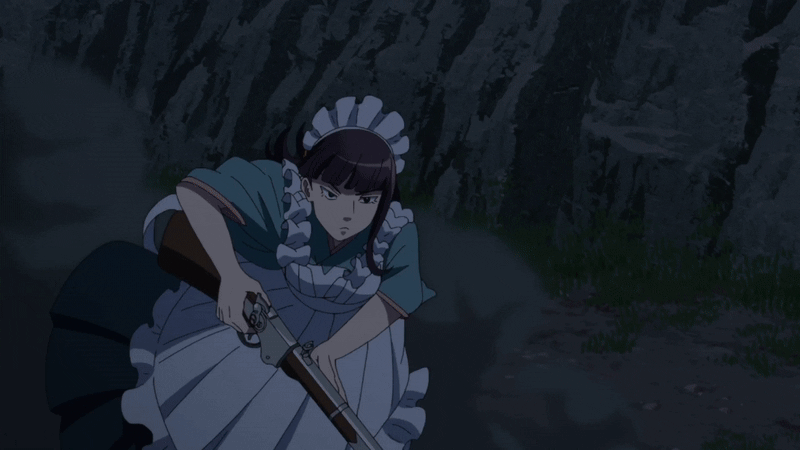
God, I wish I could share the whole episode. It's Just. That. Good.
Okay okay, last piece! This parallel during the fight that's meant to depict/explain the combat going on. I swear, this is the last bit from this fight (it's just so good I can't stop myself I'm sorry).


Sadly, I can't, so I have to try to continue trimming my thoughts down, further and further until I can reasonably leave them in a Tumblr post that doesn't go over each and every frame of the episode.
Okay, where to next? We get the reveal that the lady Tsugaru is fighting is just the maid of the only immortal person in the world, and that at this point they're only a head. We also see that this person wants Tsugaru to kill them, which sparks just more incredible scenery that I want to share every second of.

And then of course we start our wandering into town with Tsugaru and our bodiless Immortal Aya, and Lapin Track just refuses to pump the brakes and delivers the best scene from the episode.
Who is man, and who is monster? Who that exists within the confines of the cage is free to leave it with their own will? An absolutely incredible monologue from Tsugaru that exposes his character, morals, and motive, as the neither-man-nor-oni that he exists as. His desire to bring wrath upon the people that watch on and view him as a monster, that indulge in the depravity of his violence, to strike startling fear into their very beings and provide a worthy stage for him to exit on.
It's really incredible how well they weave this story into something that seems so disjointed. How they bring the idea of cages and confines in with things like Aya's birdcage or the chain link fence Tsugaru finds, how his pose and gesturing to the stage that he's created is mimicked atop the bodies that litter the ground as if he were crucified, or how the very notion of looking down on Tsugaru is made visible through this pose.
Anyways, Billy Mays here cause we're not done yet! This episode is the gift that keeps on giving, though this time it's in the form of environment art. So busy and color, but also empty and very selective, it varies wildly within the span of only a minute or two as our characters chatter on about the concept of death and dying, and their desire to live that hangs in the balance.

By some miracle I've made it towards the end of the episode in reasonable time. It's here that Aya finally accepts Tsugaru's proposal of going after Aya's body to return her to normal, and the pair seal this partnership with.... a kiss. Just puts the icing on the cake for how much of a borderline insane episode this is.

And there it is, the first episode of Undead Girl Murder Farce. Finally, an end to the insanity appears in the form of it's ending song. What a wild ride, the idea of two beings that hover between life and death, exist in a world separate of everyone else's, that find each other and embark on a journey of revenge and retribution. There's really a world to this story, and if I were forced to make a comparison? It plays a lot like an action oriented Nisioisin story might. Not quite the same oddities and idiosyncrasies, but through the many layers that characters communicate through with one another, and how they dance around ideas and ideals. Regardless of my poor attempts to explain the episode or to entice people with it though, I really hope you'll find the time to give it a change to grab you.
#undead girl murder farce#アンデッドガール・マーダーファルス#mystery anime#supernatural anime#anime recommendation#anime review#anime and manga#anime
20 notes
·
View notes
Text

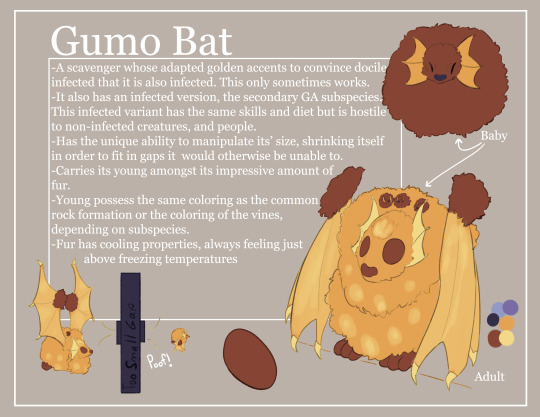
A scavenger whose adapted to blend in with its surroundings, much like the Acidstream Gecko has done.
For the Gumo Bat's case, it's evolved a purple coloring in its young to blend in with the common rock formations around Munova. Similarly, golden spots and coloring has appeared to mimic the look of infected creatures.
This mimicry is not perfect, and some infected will notice that it isn't actually infected and try to correct that. Due to these events, there are two type of Gumo Bats, not quite subspecies however as they share all of their traits.
Infected Gumo Bats are a lot more violent than their uninfected counterpart, reflexively attacking anything it sees. It does, however, possess the same rough camouflage.
Entire golden Gumo Bats mark the infected ones. Their young, in contrast to the uninfected, are a burnt orange color mimicking the vines of the Golden Absolution in order to hide their young in bundles of vines.
Both types possess one unique trait that all Gumo Bats share, rarely seen in any other species. Using Transmutation LFC, Gumo Bats possess the ability to shrink and grow themselves at will, with the only limitation being space. They primarily use this ability to get into areas they would not otherwise have access to.
Using this ability, Gumo Bats set up their nests in small crevices with even smaller entry points. These areas are often only accessible by Gumo Bats at their smallest, or their young. These nests are used as resting points and child drop off areas.
During the day, only the babies are within these crevices, subconsciously using Transmutation LFC to grow until there isn't anymore room. To those outside, they come across as a random patch of oddly fuzzy rock. When the adult returns, they use their own Transmutation to shrink the child back down.
Gumo Bats possess compound eyes for purposes of finding their children, and other Gumo Bats, when they are tiny. Being smaller tends to be better. The only exception is that larger forms can traverse longer distances, albeit being less maneuverable around tight corners. So they developed these eyes to see the smaller forms.
Uninfected Gumo Bats have been known to fight, and kill, their infected variants.
#Munova#fantasy#original fantasy#fantasy creature#fauna#I keep forgetting that one#creature#creaturepedia#creature design#I want pet this one#But I know it'll bite me#so I can't#or could I?#I would not instantly die#I think I could#I can fix him
0 notes
Note
Hello again, wizard! I hope you are having a splendid day and, if not, I hope things get better soon! Apologies if this is yet again a query at the wrong time from me, but I have a question in regards to a potential quirk idea Could there be a quirk based off the tanuki? Y’know the transforming raccoon dog spirit? Or at least a quirk based on some aspect of the folkloric creature and or its powerset? I’m very curious if you have anything in mind
I hope you are doing good as well. I’ve discussed tanukis before, but I could always go more in depth with their powers and abilities.
I'm not sure if there is much for me to work with, at least when trying to adapt the whole package. Their main trait is their ability to look like other people by using the leaf on their head. Which I think as the premise of a shapeshifting ability wouldn't make much sense as that doesn't follow the internal logic Quirks have. I was going to suggest an ability that let them possess items. That way you could have all the forms under a single power, but that's already a thing with "Mimicry". Maybe you could do a single transformation, such as the user turning into stone like tanuki do, but that seems rather removed from it. Otherwise, there isn't much to work with. I can't make a mythical Transformation out of it since all of their unique features come from their magic. It's not like a dragon where their whole body is unique enough that there is still a lot to work with. It would basically just be an Animal Mutation Quirk with extra steps. I guess "Delusion" might work, because tanuki often play tricks on single people, or "Coin Toss", since Tankui are associated with fortune. The closest I think you could get is just making an Animal Mutation with the raccoon, which I have already done. Then you can make a tanuki themed character, such as giving them a large hat that are often found on the tanuki statues or give them personality traits similar to tanuki.
5 notes
·
View notes
Text
Pica
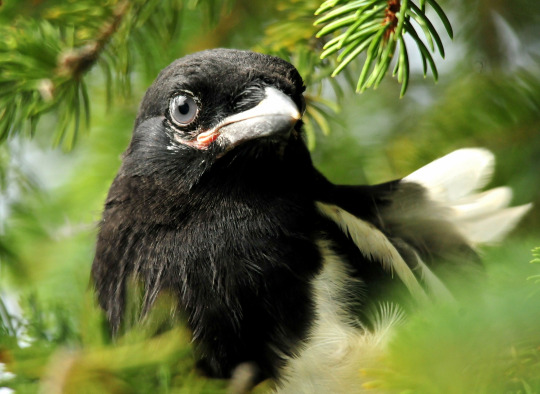
Black-Billed Magpie by USFWS, in the Public Domain
Etymology: Magpie
First Described By: Brisson, 1760
Classification: Dinosauromorpha, Dinosauriformes, Dracohors, Dinosauria, Saurischia, Eusaurischia, Theropoda, Neotheropoda, Averostra, Tetanurae, Orionides, Avetheropoda, Coelurosauria, Tyrannoraptora, Maniraptoromorpha, Maniraptoriformes, Maniraptora, Pennaraptora, Paraves, Eumaniraptora, Averaptora, Avialae, Euavialae, Avebrevicauda, Pygostaylia, Ornithothoraces, Euornithes, Ornithuromorpha, Ornithurae, Neornithes, Neognathae, Neoaves, Inopinaves, Telluraves, Australaves, Eufalconimorphae, Psittacopasserae, Passeriformes, Eupasseres, Passeri, Euoscines, Corvides, Corvoidea, Corvidae, Corvinae
Referred Species: P. mourerae, P. pica (Eurasian Magpie), P. serica (Oriental Magpie), P. bottanensis (Black-Rumped Magpie), P. asirensis (Asir Magpie), P. mauritanica (Maghreb Magpie), P. nuttalli (Yellow-Billed Magpie), P. hudsonia (Black-Billed Magpie)
Status: Extinct - Extant, Endangered - Least Concern
Time and Place: From 3.6 million years ago until today, from the Piacenzian of the Pliocene through the Holocene

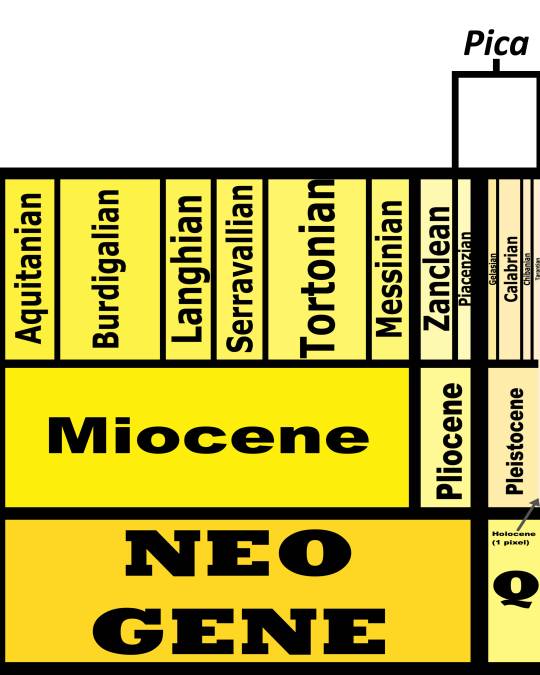
Magpies are known from all around the Northern Hemisphere
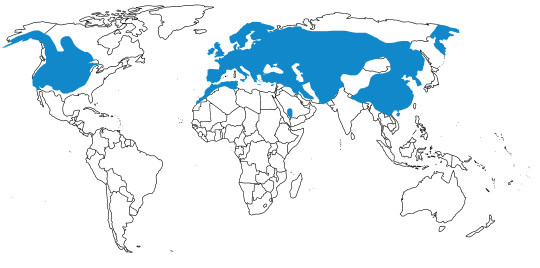
Physical Description: Magpies are beautiful, if fairly recognizable Corvids, famed from all over the Northern Hemisphere for their cleverness and beautiful plumage. They can range in size from 43 to 60 centimeters long, with the Yellow-Billed Magpie reaching the smallest sizes and the Black-Billed reaching the largest. This makes them rather large as far as songbirds are concerned, though they are still significantly smaller than the Ravens and Crows that they’re close cousins to. Magpies tend to have black backs, heads, and necks, with varying levels of black on their bodies; they then have white bellies and white tops to their wings. The rest of their wings, and tails, can be black - or an iridescent mixture of colors on a black background. These colors vary from species to species, but can be blue, green, and purple-ish tinted - at least one species can even blend into the yellow-brown range. They have thick, strongly clawed toes; and they have very large, thick beaks, like other Corvids. They have short to medium sized wings as well, indicating their adapted ability for flying between and among thick trees.

Oriental Magpie by Yoo Chung, CC BY-SA 2.5
Diet: Magpies are creative, opportunistic omnivores - they literally will eat anything. Insects, small vertebrates, eggs, carrion, leaves, fruit, seeds, your leftover pizza, that hamburger it found on the street, falafel, rice, a heaping load of spaghetti - literally, anything. It will eat anything. Hide your food.
Behavior: Magpies are clever little buggers, with complex behaviors and extensive social communication. They tend to feed on the ground, usually with other Magpies, and even in mixed-species flocks depending on the abundance of food. They’ll Pick food up from the ground and dig into soil and litter, flipping over all sorts of things to look for food - including trash and poop. They’ll also hunt live food from perches in trees, or make traps to catch flies and other insects. Some will also stick around with predators and larger scavengers, looking for roadkill and other sources of meat that could be easily gotten from. They often will also store the food, in crevices and trees and the like, though usually they don’t leave the food for long and go to pick it up in a few days. The walk around and strut, usually fearlessly, attempting to catch whatever food they can; thousands of them can often be found foraging together, and using their unique cleverness to track down food.

Black-Billed Magpie by the USFWS, in the Public Domain
Magpies are some of the smartest known animals - with large brain to body mass ratios, similar to those of cetaceans and primates; the region of their brains that works on cognitive tasks and higher thought processes is of a similar size to those found in chimpanzees and even close to those of people. As such, Magpies - much like their cousins the ravens - are some of the smartest animals alive today, probably holding second place after humans. They have high levels of social cognition, reasoning, flexibility, imagination, and ability to evaluate and predict the future. They also have very elaborate social rituals - they are able to recognize themselves, even in the mirror; and they show grief and rituals around the deaths of family members and friends. They also use tools, and use their experiences to predict the behavior of others. This knowledge of tool use is passed on from generation to generation, and modified as well - so they also have culture and rituals. They can count, imitate people, recognize words, and use tools to clean their own cages. They tend to form gangs in the wild, and use complex strategies in order to gather food and stick together. They also will ant - ie, apply ants to their plumage in order to prevent parasites and irritation - and sun-bathe to stay warm.
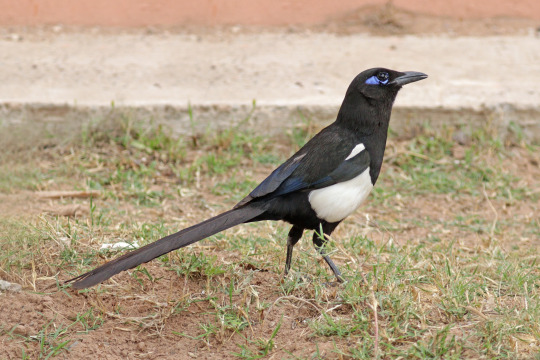
Maghreb Magpie by Charles J. Sharp, CC BY-SA 4.0
These birds roost communally and fly quite slowly over their ranges, usually interspersing their flaps with gliding to conserve energy. They make calls to flock members with regular frequency, mainly chattering and squeaking calls, as well as warbling songs and mimicry. Some species tend to have larger vocabularies than others, though they all make similar calls. Begging from the young sounds about as high pitched and peeping as one would expect. They have dominance hierarchies within the flocks formed during the non-breeding season, and dominant individuals in the flocks can and do steal food from the subordinate individuals. Interestingly enough, the younger males tend to dominate the older ones - though that may be more of a tolerance thing than anything else. These birds don’t tend to migrate, though they do move from place to place in response to climate and food availability.

Black-Rumped Magpie
Magpies are monogamous, possibly staying with the same partner for their entire lives, and multiple sets of parents will work together to tend for the nests and care for the young. They start laying eggs in the winter, though usually most eggs are laid in the early spring. The parents will build the nests together, with the male bringing materials and the female doing the building. This usually takes a couple of weeks, and at the end the pair have a large domed structure made of sticks and twigs - a very deep cup, lined with soft wool, fur, grasses, and feathers. A fresh nest is built every year, even though the pairs stay together; they’re usually built in trees, usually near to the top, though buildings are sometimes used. Old nests are sometimes reused, if they were particularly good and lasted that whole time. They lay between two and nine eggs, though of course four to six is the most common number; and they are incubated mostly by the female for about two weeks. Both sexes will then feed the chicks, while the female does most of the watching and caring for them at the nest - leaving the male in charge of gathering the food and helping to fend off predators. Other pairs may come to help - usually relatives or friends. The young will leave the nest after a month to two months, and young in the nests may come together with other young - especially if there was a communal brooding situation - to form a creche of juveniles their own age. Honestly, it’s almost like a school class in some ways, with how they behave with each other and socialize and learn from the adults. They reach sexual maturity in about one to two years, and live for six years in the wild.
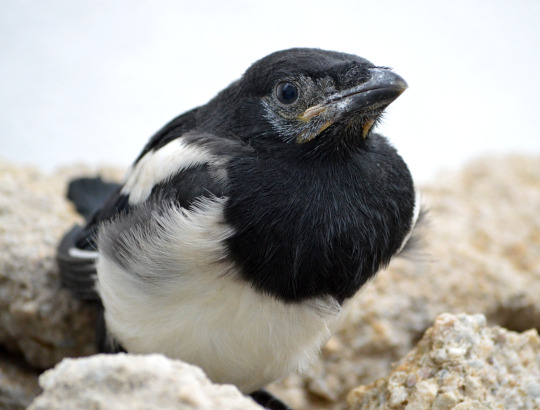
Juvenile Eurasian Magpie by Cyberolm, CC BY-SA 4.0
Speaking of friends - yes, magpies have been known to befriend humans, or at least have interactions with them. They are tame and friendly in areas where they’re left undisturbed, and in areas where they are shot at or bothered, they are defensive against humans coming into their areas. This can vary wildly, as they used to be considered viable game birds, but today they aren’t hunted as much and tend to be a little less on guard. They defend their nests violently against humans, and do not abandon them except as a last resort. Parents will mob people looking in on the nests - even scientists - especially if they are repeat offenders. But, since they recognize people’s faces, they are able to tell friend from foe (or perceived foe) and will seek out humans who give them treats or protection.
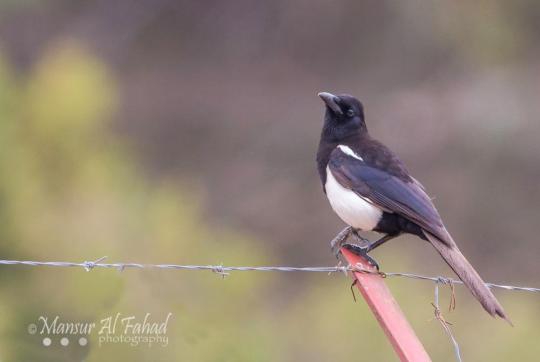
Asir Magpie by Mansur Al Fahad
Ecosystem: Magpies stick to woodland and forests, though they do venture into more suburban and developed areas depending on the availability of trees. They will also inhabit open country, so long as there are some scattered trees available. Magpies can be found in all sorts of elevations, including in the mountains and as high as 4400 meters up into them. Some species, such as the Yellow-Billed, can tolerate warmer temperatures than others. Those that encroach on human habitat are often considered pests. While they do have predators, most are killed by West-Nile virus, to which they are particularly susceptible.
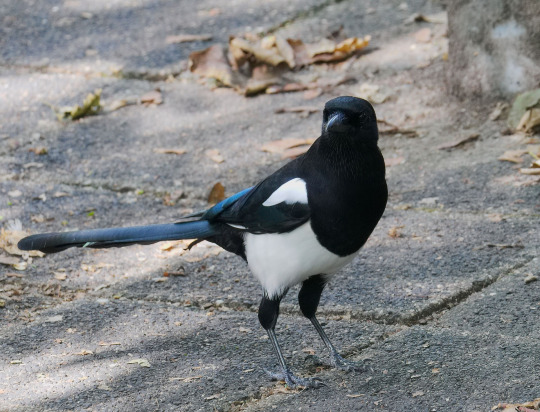
Eurasian Magpie by Andreas Eichler, CC BY-SA 4.0
Other: Magpies are Corvids, so they’re cousins with all the other ridiculously smart passerine birds, making the question of “are members of the genus Corvus or the genus Pica smarter” rather one of splitting hairs. In the end, both genera showcase extreme intelligence, and are either the second smartest animals or close to it. Honestly, if they were smarter than humans I wouldn’t be surprised - they show culture and the ability to pass down learned things from generation to generation, and they might just be smart enough to not fucking destroy the planet (unlike us). Anyways, Magpies are often thought of as pests for their ability to get at sources of human food and also steal the eggs of birds with more pretty songs, so birders actually hate them. However, they don’t actually have a negative impact on the song-bird population. Most Magpies aren’t threatened with extinction and have populations in the thousands, though the Yellow-Billed species is vulnerable due to poisons used to take care of squirrels, and the Asir species is endangered due to a restricted range and decreasing suitable habitat.

Yellow-Billed Magpie by Bill Bouton, CC BY-SA 2.0
Species Differences: The different species of Magpie differ primarily on coloration and range, as their sizes tend to be very similar. The Eurasian Magpie is often synonymized with the Oriental and Black-Rumped Magpies; whether or not these are three different species of bird is a bit of a taxonomical question. These birds range all over Eurasia - as the name suggests - with the “Oriental” subspecies (species?) being found more in Eastern Asia, and the Black-Rumped subspecies (species?) also found in Eastern Asia. At least a few varieties have a purple tail and dark blue wings; while others are more green on both the wing and tail, with only the tail tip coming out as purple. Asir Magpies are the only Magpies known from Saudi Arabia; they have dark blue wings and brownish tails, which end in a purple tip. The Maghreb Magpie is known from Northwestern Africa, and has a complete rainbow-colored tail and blue wings. The Yellow-Billed Magpie is especially distinct from the rest in having a yellow bill and yellow patches around the eyes (while the other species have black bills and black patches); they have blue wings and blueish-purple tails, and are found in California. Finally, the Black-Billed Magpie is found in the rest of North America (though not the eastern portion of the continent, or the southern), and has blue wings and a rainbow tail. There is one extinct species, P. mourerae, from the Pliocene of Spain; it seems to be very similar to living species except for that it wasn't as good of a flier - and it may have even be flightless, due to the fact that it lived on an island!
~ By Meig Dickson
Sources Under the Cut
Bekoff, M. (2009). "Animal emotions, wild justice and why they matter: Grieving magpies, a pissy baboon, and empathic elephants". Emotion, Space and Society. 2 (2): 1–4.
Clements, J. F., T. S. Schulenberg, M. J. Iliff, D. Roberson, T. A. Fredericks, B. L. Sullivan, and C. L. Wood. 2017. The eBird/Clements checklist of birds of the world: v2017
del Hoyo, J., Collar, N. & Christie, D.A. (2019). Maghreb Magpie (Pica mauritanica). In: del Hoyo, J., Elliott, A., Sargatal, J., Christie, D.A. & de Juana, E. (eds.). Handbook of the Birds of the World Alive. Lynx Edicions, Barcelona.
Emery, Nathan J.; Clayton, Nicola S. (Dec 2004). "The mentality of crows: convergent evolution of intelligence in corvids and apes". Science. 306 (5703): 1903–1907.
Madge, S. & Kirwan, G.M. (2019). Asir Magpie (Pica asirensis). In: del Hoyo, J., Elliott, A., Sargatal, J., Christie, D.A. & de Juana, E. (eds.). Handbook of the Birds of the World Alive. Lynx Edicions, Barcelona.
Madge, S., Christie, D.A. & Kirwan, G.M. (2019). Eurasian Magpie (Pica pica). In: del Hoyo, J., Elliott, A., Sargatal, J., Christie, D.A. & de Juana, E. (eds.). Handbook of the Birds of the World Alive. Lynx Edicions, Barcelona.
Marzluff, J. & de Juana, E. (2019). Black-billed Magpie (Pica hudsonia). In: del Hoyo, J., Elliott, A., Sargatal, J., Christie, D.A. & de Juana, E. (eds.). Handbook of the Birds of the World Alive. Lynx Edicions, Barcelona.
Marzluff, J. & Sharpe, C.J. (2019). Yellow-billed Magpie (Pica nutalli). In: del Hoyo, J., Elliott, A., Sargatal, J., Christie, D.A. & de Juana, E. (eds.). Handbook of the Birds of the World Alive. Lynx Edicions, Barcelona.
Mourer-Chauvire, C., J. A. Alcover, S. Moya and J. Pons. 1980. Une nouvelle forme insulaire d'effraie geante, Tyto balearica n. sp. (Aves, Strigiformes), du Plio-Pleistocene des Baleares. Geobios 13(5):803-811.
Parmalee, P. W. 1992. A late Pleistocene avifauna from northwestern Alabama. Science Series, Los Angeles Museum of Natural History, Science, and Art 36:307-318.
Segui, B. 2001. A new species of Pica (Aves: Corvidae) from the Plio-Pleistocene of Mallorca, Balearic Islands (Western Mediterranean). Geobios 34(3):339-347.
Wetmore, A. 1962. Notes on fossil and subfossil birds. Smithsonian Miscellaneous Collections 145(2):1-17.
#Pica#Magpie#Corvid#Passeriform#Dinosaur#Songbird#Perching Bird#Dinosaurs#Birds#Bird#Facfile#Songbird Saturday & Sunday#Birblr#Palaeoblr#Factfile#Omnivore#Neogene#Quaternary#North America#Eurasia#Africa#Prehistoric Life#Paleontology#Prehistory#Pica mourerae#Eurasian Magpie#Asir Magpie#Maghreb Magpie#Yellow-Billed Magpie#Black-Billed Magpie
166 notes
·
View notes
Text
This is about as far as I got for their society and stuff, cause I got tired, but feel free to ask any questions if I left something out that you wanna know about!
Also, I’ll draw some clothing for the Aschall later.


Thiery is a doctor turned field medic. She is niece to Councilwoman Haenna. Her aunt took her in after her parents disappeared while she was little.
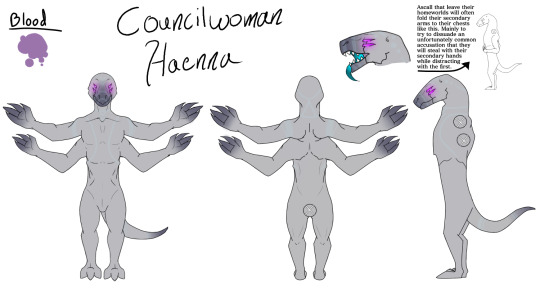

Councilwoman Haenna is a prominent figure in Ascall Society. Despite not being one of the representatives of her clan, she is often asked to attend meetings via holo/comm. She is very protective of her son, and of Thiery, having lost her other two children.


Teyrdok “Tayer” is the Ascall Councilor’s only child, and is cousin to Thiery. He and his small family of three are some of the few on the Citadel who haven’t taken the Vow of Silence. In his hometown, he helps mentors train young Aschall who have turned 17.

Average 5′6″ Human compared to an Ascall.
[Homeworlds]
- Their homeworlds, Annivus and Davos, orbit in close proximity to a very powerful sun. One that burns most to a crisp if they aren’t adapted to living on the planets’ surfaces. So, very very early on in their evolution, the Ascall moved underground, into caverns and caves.
- The size of the planets is comparable to Neptune (Davos), and Uranus (Annivus).
- Nowadays, there are vast cities built into the dense stone. The cities and towns span across the entirety of their planets, and have different levels beneath the first you enter in. Some of the largest populations can have thousands of feet worth of levels.
- Although the cities have elevators and escalators to help span the distance, smaller towns will have ramps and stairs, and even smaller villas will have vertical tunnels between each level, with foot and hand holds dug into the walls. The tunnels are large enough to fit a Krogan, and often require you to wear some sort of harness and tether in case you aren’t used to the structures or can’t hold onto the holds. The tether attaches to a sturdy metal pipe off to the left of the ‘ladder’, and can be clamped tightly to stop one from falling.
- Most of the planets’ surfaces is completely barren, mostly stone valleys, plains, and mountains. But there are large oases (oasis plural), dotted where the sunlight touches least. And there, hardy plants grow. The plants are largely inedible to Ascall, but not to the Betrite that frequent the oases and migrate to find more.
- Underground fresh water rivers, springs, and aquifers are primarily how the Ascall get hydrated. Their largest cities were built near the aquifers, and the towns are closer to rivers and springs.
- The oases evaporate when the sun is in direct contact with them, causing local wild fauna to migrate daily to more shady areas of the planet to find better water sources. The bodies of water refill rapidly when the sun is not in direct contact with them. It storms at night, the evaporated water refilling the empty pools.
- On occasion, the storms can get to be so bad, that thick metal storm doors will close over the entrances to the cities and towns.
- There are few entrances to the underground. Possibly four at most. Vast tunnels with an occasional shop in the walls connect all of the populations.
[Society]
- Generally, they are a rather friendly people. They are very fond of Found Family and will often adopt others into their family. If you ever go to visit the Ascall homeworlds, you can find people of most species, either visiting, or having been raised there.
- Because of this eagerness to include others, there is a stark lack of clan names, or group identifying names. Usually, when talking about a specific clan, the entirety will be referred to as [Insert Name]’s Clan. Generally, the clans are old enough, and their leaders are recognized enough that they can easily avoid tacking a name onto a clan.
- While there are no IDs for the clans, there are prominent 3 leaders. Chosen by the clans themselves to represent them when decisions must be made for either an individual clan’s problems, or for the species as a whole. One leader is selected for their knowledge of the clan’s current agricultural/cultural representation, another is selected for the medical representation, and the third is selected for the Protection representation.
- Ascall have no straight military. Rather each child born into a family is taught the basics of weaponry, protection, and guerilla tactics at age 17. If they so choose, when the need arises, they can volunteer to help protect their people (IE; The Reaper Invasion).
- Many Ascall do volunteer when necessary. But it is often a last resort. If they cannot see any way to reason with or calm their aggressor, they will take up arms.
- *Most Ascall that leave their homeworld to visit or live on the Citadel will often take a Vow of Silence. Their ability to copy a vast majority of voices leaves a lot of people unsettled, so in attempt to quell any suspicions, or accusations, the Vow of Silence is offered to those going to the Citadel, by an Ascall Ambassador. It can be refused, or accepted, but it is solely up to the recipient.
- The Vow of Silence is only in effect while on the Citadel, and the Ascall that accept it can speak when not on Citadel bound transport, or on the Citadel itself. The Vow in and of itself is just a strip of fabric often tied around the right wrist of their secondary arms.
- **While on their homeworlds, those that chose to walk on 4/6 of their limbs will have tough gloves for their secondary hands. It’s considered an offense to greet others while wearing the gloves, or to eat with them on, as it’s seen as eating/greeting with all of the dirt and filth left behind on the ground from people walking about.
- Ascall have adapted a lot of names from other species, you will commonly find Ascall with human, Turian, Quarian, Krogan, Salarian, Asari, etc. names.
[Flora and Fauna]
Betrite: Large thick plated herbivores, similar in weight and height to human draft horses. They travel in herds, and wild Betrite are largely aggressive, but easily fooled by mimicry. They will always investigate the sounds of other injured Betrite. They have heads similarly shaped to Varren, two small eyes, large nostrils, round disk shaped ears, and six thick legs with padded paws. Although they can’t curl up like Armadillos do, their plating patterns are quite similar to them.
Domesticated Betrite are far less aggressive, but also far less inclined to do anything other than what they want to do. They’re very stubborn creatures.
[Biology]
- First and foremost, the Ascall are an extremely flexible species. Soft flesh, and collapsible spines allow them to squeeze into places that would be hard to reach for most others, even despite their tall stature. Before they had the abilities to create cities and towns within the caverns they inhabited, when they were still primarily a hunter-gatherer society, they would force their way into whatever dark crevice they could, if they couldn’t make it back to their caves before sunrise.
- Also, an evolutionary trait that stuck with them through the generations, is a secondary larynx. When both larynxes are in use, they can mimic most if not all sounds, and most voices.* Some millennia before they had begun to farm the larger prey animals that could walk their planets’ surfaces, they would mimic cries of injured members of the Betrite. This in turn would lure prey to the cave/cavern openings to be ambushed. This saved them from having to go out into the damaging sunlight when their food stores began to run low.
- Due to a diet of mostly glowing fungi that grows in the caverns they live in, and what meat they can get, combined with often living in darkness, Ascall have developed Bioluminescent patterns. Each pattern is unique to that Ascall specifically. Although relatives may have similar markings and colors, no two will never ever be the same, like a human fingerprint. The glowing mouths are a side effect sort of evolution. Their mouths will always glow, regardless of whether in light. But their markings will only glow in low light or in complete darkness.
- Ascalls are often dark or muted colors, but fade to gray as they grow older. Councilwoman Haenna used to be a rich dark purple but has grayed out as she reached her fifties.
- The purpose of the secondary arms is a question that has largely gone unanswered, due to a lack of data and evidence. But on their homeworlds, most Ascall will either pick between walking bipedal, or using their secondary hands and their legs, while their first hands will remain free to grab things.**
- All reproductive organs, regardless of sex, are hidden in their bodies until time for their use.
- Ascall have rather durable internal organs, lengthened to enable their flexibility, but not resistant to being punctured.
- Ascall have litters of 2-4 young.
6 notes
·
View notes
Text
( Demonic species; )

Detterick’s Logs # ████ Entry # ███ Demonic species & subspecies inhabiting the (former) Kingdom
“ Traveling, leafing through documented, concrete proofs, recording knowledge from the world’s inhabitants, and my own researches have brought to my attention the existence of five demonic species, namely Demons from the Desert, Forests, Mountains, Oceans, and Shadows, as well as two subspecies, known as Pureblood and Winter Demons. A third subspecies, Impure Demons, has been recorded through nearly every era, although much like Pureblood Demons, the occurrence of such beings seem to gradually, but inevitably decrease over the course of history. Below, details I compiled about each of these species ( generic appearance, lifespan, occult powers... ), some from researches alone, other from direct observation. As subspecies, Pureblood, Winter, and Impure Demons have been classed at the bottom of the list. “
DESERT DEMONS ( sometimes referred to as Desert Sirens, Sand Demons ) - Demons roaming the endless deserts are skeletal, ghostly figures of average height and build, dragging themselves on sand with their arms and long tusks, as they often lack legs altogether. They survive in large hive-like communities, counting from a few dozens Demons up to a few hundreds, aware of all of the individual’s whereabouts, communicating the location of food and of the approach of danger thought the sharing of one collective mind amongst a specific hive. They are thus considered a highly gregarious species, and it is rare to encounter a Desert Demon alone. Digging complex tunnels under the desert’s seemingly uneventful surface, they have a hierarchy with a Queen or King at the source of the hive’s core, but no such things as classes or ranks amongst themselves. Queens and Kings assure their hive’s well-being, but have no reproductive roles. Level of threat - They easily trade important tools, food, and other necessities between hives, as well as with humans’ settlements scattered along the desert’s shore. Desert Demons hunt small prey animals, but will not attack preys bigger than them ( including humans ) unless they are starved, or if their hive has been dismantled without them relocating safely somewhere new. Lifespan - Desert Demons are known to thrive so long as their Queen or King is alive. Likewise, Queens and Kings will survive so long as their hive’s well-being is assured. Occult powers - Fortune telling, divination, and clairvoyance are the most common and widespread occult powers amongst Demons from the desert. Strength of occult powers vary from one individual to the next, but rarely include other talents. Chimeras - Desert Demons are genetically compatible with those from the Shadows, Pureblood, and potentially Forest Demons as well. Impures - No. Trivia - Desert Demons have one of the most complex and specific language out of every demonic species // Relationships are rarely formed within members of a same hive // You can trade almost anything to them in exchange of books, as well as carpets, provided the fabrics used have bright colors
FOREST DEMONS ( sometime referred to as Extraterrestrial Species, I wish this was a joke ) - Surviving in the Kingdom’s numerous forests, these Demons have an excessive variation in their body shapes, from tall and bulky to short and emaciated with any possible combination in between. As of such, Forest Demons appear to be amongst some of the most diverse demonic species. They create their own monarchy, delimiting boundaries and territories based on available resources. The villages and cities are built in trees, in the unique goal of blending in their environment. Habitations and various installments are easy to take down and move to a new location should their hide-out be discovered, and the intruders impossible to push out. Level of threat - For the most part, Forest Demons survive on an agricultural lifestyle, with livestock and crops, alongside what their forest has to offer them. While not hostile, they would rather not dwell with the outside world since the fall of the Kingdom. They can represent a serious danger should they opt to get the intruders out rather than simply move their own village out of the way, but for the most part, I would say Forest Demons do not pose a threat, unless you just so happen to look like their favourite berries. Lifespan - Forest Demons have a rather short lifespan, living for about 50 to 100 years. This is tied in no way with the resources found on their territories, and seem to be the direct consequence of their biological constitution. Further researches are needed to confirm this hypothesis, or not, but I haven’t gotten my hands on any specimen to dissect just yet. Maybe because it’s not my field. Occult powers - Matter manipulation happens to be the occult power most commonly known to Forest Demons. Anything that is solid enough to hold a shape can be manipulated, so long as it is within a decent reach of the Demon. The distance at which a Demon can hold power over matter varies from one individual to the next, but it appears to range from roughly ten feet in any direction, to three time the same distance. Chimeras - Genetically compatible with Shadows, Purebloods, Mountains, as well as potentially Desert Demons. Impures - No. Trivia - Forest Demons do not commonly form relationship within members of the same village. // Their food is actually very delicious, they may be the most skilled cooks amongst Demons.
MOUNTAIN DEMONS ( no other known names ) - Building their homes in mountains, caves, grotto, and underground, Mountain Demons have the widest range of habitats, and are by far the most diverse and adaptable demonic species. With some barely a foot tall and others towering over eight feet and even taller, they showcase an amazing ability to survive any environment or climate, and are thus widely spread through the ruins of the whole Kingdom. Living in small communities, they are mostly nomads staying with family members, departing when it is time for them to set up a home on their own. Ruins and remains of Mountain Demons’ settlements are scattered about just everywhere, and represent easily accessible finds. Level of threat - Mountain Demons are mostly known for being peaceful beings, sharing their settlements and stories with travelers, and trading with anyone who has something interesting to offer them. They are rarely encountered in broad daylight, however, and will leave their settlements before sun rises should they have shared it with travelers through the night. They do not appear to be thieves either, or I simply do not carry anything of value to them, ever. Lifespan - Incredibly diverse as they are, these Demons’ lifespans range from a few centuries to thousand of years. Natural disasters, injuries, and illnesses, are the most common cause of death, rather than old age. Occult powers - Mimicry is their occult power, and nearly every single Mountain Demon possesses that talent to an above average level. This helps them adapt to new environments and prosper no matter where they settle. They can not shapeshift, however, they only mimic the living beings around them to survive. This includes humans. Chimeras - Forest, Pureblood, and Shadow Demons. Impures - No. Trivia - There’s nothing Mountain Demons love more than an exciting tale of adventure, and they will beckon travelers to share their stories with them around a campfire. // Exactly how they sustain themselves is currently unknown. I have found no written evidence of them sharing food with travelers, nor have I heard a recipe from them myself.
OCEAN DEMONS ( sometimes referred to as Sea Demons, Sirens, Merfolks ) - Just as the name implies, Ocean Demons ressemble your typical folklore mermaids and mermen. Found in bodies of water, mostly lakes and rivers, they are nearly extinct nowadays, as the ocean they originate from is now permanently frozen following the Kingdom’s fall. With fish-like features, they can present themselves in all colors, with any kind of fins or length of tails. Little else is known considering how rare and fearful they have become through the eras, but it is widely accepted they have a strict hierarchy and multiple classes amongst a single shiver. Level of threat - They are not friendly, they do not want to be approached, they want to be left in peace. As opposants to the Altesse’s reign, they have been doing their things on the side without asking for anyone’s help for eons, now. Lifespan - A few centuries, perhaps longer for those dwelling in depths. It has not been properly measured in quite some time, and yours’ truly has not been granted enough funds to buy a submarine and verify for himself. Unfair, is it not? It would be in the name of science, but now it’s too late and I’m not building a submarine myself (unless....) Occult powers - Mirages, for the most part, are created by Ocean Demons. While not proper illusions or hallucinations, they can cover up the reality with their own. Chimeras - Pureblood, Shadows. Impures - No. Trivia - ???
SHADOW DEMONS ( sometimes referred to as Darkness Demons, Shadows, Half-Limbs ) - Born in the world’s darkest corners, Shadow Demons are creatures spread through the entirety of it, including through humans’ towns, cities, villages. It’s widely accepted that, where there is a darker spot, there is a Shadow Demon. Inheriting their nickname of “Half-Limbs” from the fact an overwhelming majority of them appears to be permanently fused with darkness, they mostly possess a left arm, sometimes a left leg, part of a face, a vaguely human-like silhouette, and always an odd number of eyes. Their demonic appearances are shrouded in shadows in perpetual motion, retaining the same odd number of eyes, and their population seems to be rather stable through the ages. Level of threat - Shadow Demons are friendly, curious, social creatures, who watch from afar, only mingling with other beings when they can safely acquire a body. They pose no threats to other demonic species nor humans, but their demonic appearances are some of the most fear-inducing, according to witnesses. Lifespan - They will outlive every other beings that have even walked this earth. Occult powers - Shadow Demons have access to a specific talent referred to as Elsewheres, allowing them to erase objects out of existence, and fetch them back later. Some people have theorized this is where their missing half of a body is permanently stuck at, but there is no real way to prove such sayings. Elsewheres can store objects of varying sizes in all shapes and sizes, living things, literal spaces, and who knows what else (you? me? sounds like a nice vacation spot, if you ask me.) Chimeras - Every known species of Demons, except Winter Demons. Impures - Yes I’d have never guessed. Signs of a Shadow Impure include: complete heterochromia with a stark contract between the two eyes’ colors ( shifting Impures, sucks to be me ), lack of pupils, sometimes lacking limbs or body parts most often on the right side. Shifting Impures born form a Shadow Demon are also amongst the most gigantic demonic appearances out there, and will have an odd number of eyes under such looks. Trivia - I wonder if they are connected to Nothingness? Why the odd number of eyes? Is it just for the sake of the pun with Impures having an odd eye? That sounds like something these tricksters would purposefully evolve to do.
DEMONIC SUBSPECIES
IMPURE DEMONS ( sometimes known as only Impures ) - Impure Demons are born from the union of a Demon and a not-Demon ( that we will call “humans” here for the sake of simplicity ), and only two species of Demons are known to be genetically compatible with humans: Shadows, and Purebloods. From there onward, Impures can be divided in the following two categories: shifting Impures, and occult Impures. An Impure born as both is unheard of, and anyone telling you otherwise is talking bollocks and you should tell them. Impures are always born as twins, even if both children do not always survive, usually one of both. Shifting Impures are most often left for dead than occult Impures, but you know, the world will keep on turning no matter what. Shifting Impures - Recognizable by their complete heterochromia ( with metallic hues for Impures of Purebloods, or highly contrasted colors with a lack of pupils for Impures of Shadows ), their ability to shift into a demonic appearance, and the need to be bled out so the demonic side of themselves do not overtake the human side completely. Occult Impures - Almost purely human looking, these Impures possess an occult power, usually that of their demonic parent, but not always. Why, and how is still highly debatable as far as I am concerned. No, I will not ask my brother. There’s slightly more info on Impures under entries for Shadow and Pureblood Demons. I’d need to make a separate log to fit all I’ve personally learnt about Impures in the last years.
PUREBLOOD DEMONS ( or just Purebloods ) - Purebloods are found in every single demonic species all around the Kingdom, and are thus considered more of a subspecies than a distinct species. Born from demonic parents of the same species and never Impures, they appear to be a perfected, refined version of their direct lineage, with unique features ( iridescent hair, horizontal pupils, metallic hues to their eyes... ), longer lifespans, and more dangerous occult powers. They are not, however, considered a part of said species - a Pureblood Demon born from Forest Demons, is thus only a Pureblood, and not from the Forests. They also happen to be the only species able to transform into non-living demonic classes such as Armors or Ghosts. Alongside Impures, Purebloods appear to have a greater connection between their demonic side and their “human looks”, sharing traits and characteristics between the two - a “share” that is not observed in any other species. They inhabit every part of the Kingdom, and have gotten increasingly rarer after said Kingdom’s fall. Level of threat - Varies greatly, depending of the species the Pureblood was born from. As a whole, however, Pureblood Demons are more dangerous towards their own kind than their are towards humans. Lifespan - Greatly increased, can reach a few thousand years with ease before the first signs of old age manifest. They are mostly immune to illnesses and heal much faster than most other Demons. They are a durable and adaptable species. Occult powers - While Purebloods can inherit from the occult power of their species times twenty-five, they also possess an unique one, namely the ability to perform Exorcisms. Which, in other words, allow them to tear the souls of other Demons out. This talent pushes many parents of actual Purebloods to either kill their offspring young, or abandon them. Chimeras - Every known species of Demons, except Winter. Impures - Yes. Signs of a Pureblood Impures include: complete heterochromia ( shifting Impure ), metallic hues to the eyes, natural markings at birth, potential occult power developed at a young age. Trivia - Impures tend to be fairly tall, no matter their species of origin // Despite being immune to most illnesses, they often have genetic disorders that can be transmitted to Impures. // The near perfect share between their demonic side and their human looks seems to be responsible for these genetic misshapes.
WINTER DEMONS - probably just Mountain Demons who have adapted themselves to the harsh climate of the arctic, frozen lands, until they became a subspecies. Excessively tall, able to survive for eons, amazing climbers, possessing a lot of arms, quite a quantity of horns, everything seems to point out they’re not a different species altogether. They have no demonic appearance, however, and can perform necromancy. Take these info as you want. The day I find a coat and boots warm enough to keep me from freezing at the very limit of their territories, I will add more info about this fascinating subspecies of Demons, but sadly, this day will not be today. Throw in some gloves tho, and I’m leaving tomorrow morning.
#long post#( headcanons; )#( detterick's logs; lore )#first real lore drop of this blog#now that i've added the scientist boy#i hope y'all are expecting more because there will be more
1 note
·
View note
Text
Neji Powers/Abilities
Jutsu
Eight Trigrams Mountain Crusher (Anime only)
Eight Trigrams One Hundred Twenty-Eight Palms (Anime only)
Eight Trigrams Palms Revolving Heaven
Eight Trigrams Sixty-Four Palms
Eight Trigrams Vacuum Palm
Eight Trigrams Vacuum Wall Palm
Gentle Fist
Gentle Fist Art One Blow Body
Gentle Fist: Tenketsu Needle (Anime only)
Palm Bottom
Nature Type
Fire Release
Earth Release
Water Release
Updated Powers/Abilities For Neji, Clearly, not Canon. But official for this blog in most threads. He has gained these powers through vigorous training and such. But also the reason behind him having these new, non naruto-y powers is because he was experimented on, and acquired them through a meme of random chance. And of course this comes with weaknesses. Prolonged uses leave lingering effects and causes him to exhaust far quicker. Sometimes powers get stuck/linger aesthetically on his skin against his will, often causing small amounts of damage to him/others. Some of these powers do not work as Neji would wish them to. Often times he will try to use one, and use the other. Or nothing at all. Other times he can successfully use an ability from these new powers with ease. It’s all dependent on how I’m feeling, or what I roll in a Random Chance.
Air/Wind
Aerokinesis - manipulate the air, wind, and gas.
Aeroportation - teleport using air/wind currents.
Air Mimicry - transform into a cloud of gas, fog, or mist.
Atmokinesis - manipulate the weather by mixing water, ice, fire, earth, air, and lightning/electricity.
Deoxygenation - suck up all the oxygen from a place.
Lung Adaptation - breathe anywhere.
Wind Generation - create blasts of wind.
Air Generation - create or generate blasts of air.
Aeromancy - Divination via air/wind currents.
Nubikinesis - manipulate clouds.
Pure Wind/Air Manipulation - create and control pure winds.
Dark Wind/Air Manipulation - create and control corrupted winds.
Flight - have the ability to fly at will.
Levitation - the ability to make anything rise up in the air and move around under your control.
Earth
Geokinesis - control, manipulate, create, generate and reshape or shape earth/rocks/stones
Earth Mimicry - have a body made up of earth or earthen substance
Agrokinesis - manipulate plants at will.
Atmokinesis - control and manipulate the weather by mixing water, ice, fire, earth, air, and lightning/electricity.
Crystallokinesis - manipulate minerals and crystals.
Ferrokinesis - manipulate metal at will.
Geo-Thermokinesis - manipulate, control, and create lava, magma and volcanoes.
Golem Creation - make golems out of inanimate materials like rocks, wood, plants, magma, etc.
Granulation - can turn things into sand.
Geomancy-- Divination via earth and earth-based minerals.
Halokinesis - control and manipulate salt.
Hyalokinesis - control and manipulate glass.
Koniokinesis - manipulate and control dust particles.
Plassikinesis - manipulate and control all forms of plastic.
Psammokinesis - can control and manipulate sand.
Terrakinesis - control, manipulate and alter/reshape the surrounding terrain and landscape at will.
Terraportation - teleport via the earth and earth-based materials.
Pure Earth Manipulation - Create, manipulate and control pure and good earth minerals.
Black Earth Manipulation - Create, manipulate and control corrupted and evil earth minerals.
Fire
Pyrokinesis - create, control and manipulate also generate fire, flame and heat.
Atmokinesis - control and manipulate the weather by mixing water, ice, fire, earth, air, and lightning/electricity.
Fire Breath - breathe out flames.
Fire Mimicry - have a body made up of fire
Geo-Thermokinesis - manipulate lava, magma and volcanoes.
Heliokinesis - manipulate and control the sun and sunlight.
Dark Fire Manipulation - Generate and control flames of destruction.
Hell-Fire Manipulation - Generate and control flames of hell.
Holy Fire Manipulation - Generate and control flames of Heaven.
Inflammation - burn things.
Melting - heat molecules to melt things.
Plasmakinesis - control plasma.
Pyromancy- Divination via fire.
Pyrotechnics - create fireworks.
Self-Detonation - explode self and reform.
Stellar Manipulation - manipulate and control stars.
Thermokinesis - create, control and manipulate heat.
Pyroportation - teleport or move though fire.
Water
Hydrokinesis - manipulate and control liquid water and mold it into any desired shape or form.
Aquatic Adaptation - adapted to underwater living.
Aquatic Breathing - breathe underwater.
Atmokinesis - control and manipulate the various aspects of the weather by mixing water, ice, fire, earth, air, and lightning/electricity.
Dehydration - absorb water.
Hydroportation - teleport across short or long distances through liquid water.
Hydromancy - Divination via water.
Water Mimicry - turn into liquid water.
Water Generation - generate water.
Holy Water Manipulation - create, manipulate and control graceful waters.
Dark Water Manipulation - create, manipulate and control evil and dangerous waters.
Darkness
Umbrakinesis - can manipulate and control darkness or shadows.
Darkness Mimicry - become the darkness.
Animated Shadow - Animate one's shadow.
Light Absorption - block out light in an area.
Night Vision - able to see in the dark.
Sacred Darkness - create holy darkness.
Shadow Camouflage - be unseen in shadows.
Umbraportation - teleport via the shadows and darkness.
Electricity/Lightning
Atmokinesis - control and manipulate the weather by mixing water, ice, fire, earth, air, and lightning/electricity.
Quintessence Force - generates whitish-blue lightning that also contains pure life energy.
Electrokinesis - control, generate or absorb electric fields and shoot lightning bolts.
Activation & Deactivation - turn stuff on and off.
Positron Manipulation - control positrons, the antimatter counterpart to electrons.
Electrical Absorption - absorb electricity.
Electric Mimicry - transform entire body into a lightning-like being of pure electrical energy.
Electroportation - teleport with lightning/electricity
Divine Lightning Manipulation - create and control the brightest lightning.
Black Lightning Manipulation - create and control the darkest lightning.
Energy
Dynamokinesis - manipulate existing energy.
Energy Blast - create blasts of energy.
Energy Emission - release energy.
Quintessence Force - create and manipulate unique form of Soul and Heart Energies.
Mana Manipulation - manipulate magical energies.
Chi Manipulation - manipulate metaphysical life energies.
Omnikinesis - manipulate absolutely any form of energy and matter.
Gyrokinesis - manipulate gravity.
Sonokinesis - manipulate sound.
Magnetokinesis - manipulate magnetic energy.
Omni-Psionics - can use many psionic abilities such as empathy, telepathy, and telekinesis.
Energy Manipulation - manipulate and/or generate energy.
Sphere Manipulation - able to manipulate a energetic force field around yourself.
Chronokinesis - manipulate and/or control all of time, see through it, exist in multiple places throughout time at once, and change the past or future.
Spatiokinesis - manipulate space.
Cosmokinesis - manipulate all cosmic forces.
Exotic Matter Manipulation - control and create matter that defy laws of science and reality.
Spatiochronokinesis - manipulate the space-time continuum.
Ice
Atmokinesis - control and manipulate the weather by mixing water, ice, fire, earth, air, and lightning/electricity.
Cryokinesis - control ice, snow and other forms of frozen water.
Freeze Breath - freeze things in solid ice.
Freezing - lower the temperature in kinetic atoms to freezing temperatures.
Frigokinesis - control snow either as precipitation or already on the ground.
Ice Mimicry - have a body made up of ice
Ice Beam - shoot beams of freezing energy.
Ice Generation - generate ice, similar to Water Generation.
Ice Absorption - absorb ice.
Ice-Fire Manipulation - Fire that is cold as ice.
Light
Dark Light Manipulation - create the darkest light in existence.
White Light Manipulation - create the purest light in existence.
Photokinesis - create and manipulate pure light and photons.
Force-Field Generation - create protective shields of solid photons.
Invisibility - be unseen.
Laser Emission - bend light wavelengths to create lasers.
Light Absorption - absorb the light around you.
Light Generation - emit blinding light or glow in the dark.
Light Mimicry - take on the traits of light.
Photoportation - teleport by using light.
Projective Invisibility - turn other things invisible.
Rainbow Manipulation - manipulate rainbows.
Evil Banish - banish all spirits of evil and black magic.
Absolute Light - The user can create a field of absolute light that blinds the targets either temporarily or permanently and may also dull or even completely negate the other senses.
1 note
·
View note
Text
Shifting Sands Chapter 3: Natives of Evil
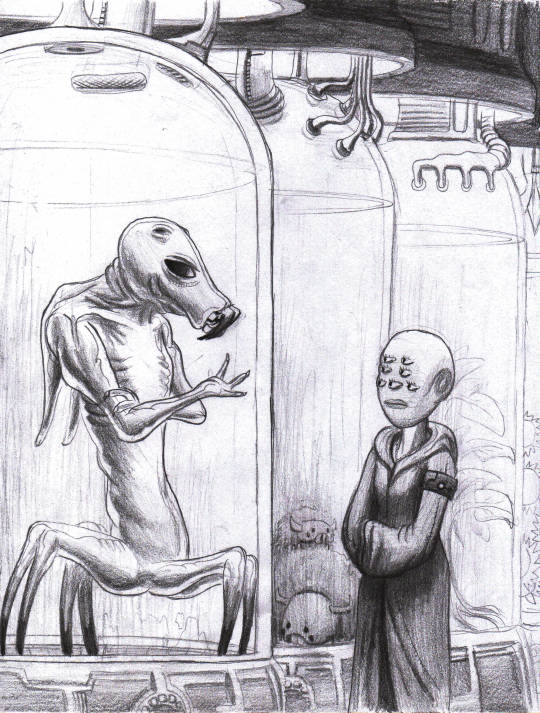
Chapters: One Two Three
“Frankly, I don’t see what all the fuss is about.” A new creature stood in the lab, staring into her tube. A tall, important-looking, proud specimen that fiddled its right tentacle like a nervous tick. “It isn’t even very big.”
“She can get bigger, Captain.” One of the scientists replied. “We’re not quite sure how, but she was in the form of a full-grown scientist when the drones recaptured it…”
“Oh really?” The Captain blinked. “One of you?”
“Me, sir. She took my from.” Dr. Zlfo]n raised his tentacle.
“Huh… So what else can it shapeshift into?” The Captain bent closer to her tube, and looked right into her eyes. “Anything it sees?”
“We’re not sure, sir. She’s been… Uncooperative. The recent breach was the only time we’ve ever directly seen her display the ability, although… Although others of her species displayed remarkable capability during the attack…”
“Hmm… Hey! Hey you! Creature!” The Captain tapped on the glass. “Mimic something! …How about this? Can you mimic this?” He made a face, rolled his eyes outward and stuck out his tongues. He glanced back at the men after an uneventful moment of silence. “…Can it understand me?”
“No sir. The translator circuit isn’t even on.”
“Heh heh…” The Captain chuckled. “So how did it breach containment anyway?”
“The, uh… The late Dr. &R/\BJ lowered security measures in order to show her around the ship. Her container must have been mishandled, and allowed to shatter…”
“Hmph! And what could have possibly possessed that old fool to allow something so hairbrained?”
“We believe he… Struck up a friendship of some type with her, sir. He sent everyone out of the room to make her feel more at ease, so we never got the particulars.”
“Well, that was certainly preventable, now isn’t it?” The Captain scoffed, putting his tentacles on his hips. “I’m running a science vessel here, men. Not a nursery. From now on, I expect no such mistakes. No unmonitored communication with intelligent specimens, no unnccessary transfer of specimens between containers, no undue consideration for specimen desires. And that’s all they are; specimens. Understood?”
“Yes sir.” They all chorused.
“And as for this one…” He turned back to her tube. “Hmm… How well did it mimic Dr. Zlfo]n?”
“As far as we could tell, it was an exact physical match…” Dr. Zlfo]n admitted. “Save for some alternative chemistry, and of course the microscopic details.”
“…You know, we could sell these.” The Captain mused. “Spies, agents, soldiers, circus performers, the like… A lot of people would pay top money for this kind of thing. Pity we only have one… Can we clone it?”
“Unlikely, sir. It constantly shifts its DNA patterns, even in its base form. If we tried to clone a sample, we’d just as likely end up with an incomplete portion of one of its mimicry forms. We believe that microscopic adaptation on the protein level is a foundational function of its—”
“Oh, Lord, spare me.” The Captain motioned the scientist to silence. “So you’re saying we can’t clone it, and it’s too dangerous to contain. It’s of no use to us, then. Jettison it.”
“SIR!” The youngest scientist, Dr. cl;**4, spoke up. “Sir, I don’t know if killing her is the best idea…”
“Oh?” The Captain spun on him. “And what might you suggest?”
“Well…” The young man’s voice faltered. “Well, we could… We could lock her in a passenger dorm to keep her happy; those are airtight, so she couldn’t get out, and… Or… Or we could send her back to her homeworld…”
“Ohhhh, okay. Okay I see.” The Captain scoffed. “You suggest we waste an automated prison droid sending it aaaall the way back across the galaxy… Or we waste space and money by giving it a whole plethora of commodities reserved for paying passengers…”
“Well…” Dr. cl;**4’s eyes fell, and he stuttered. “O-o-or… Or keep her here and keep a better eye on her, I-I-I mean, it just seems like a bad idea to… Kill her… You… I mean, you… Uh… Never mind.”
“I what?” The Captain moved closer to him. “What were you about to say?”
“Nothing sir. Never mind.”
“Were you going to give me a warning of some type?” The Captain prodded. “Remind me of something? Yeah, that’s it, isn’t it. You were going to remind me of a warning. What was it?”
“Nothing. Sir.”
“Come now, son.” The Captain’s voice got low and cold, even slightly threatening, as he put a tentacle around cl;**4’s torso. “Come now. Don’t be afraid to speak your mind. We are men of science, aren’t we? And science isn’t afraid of a few inconvenient or uncomfortable claims, no matter how groundless they may be. Come now, scientist. State your hypothesis.”
“The… The…” cl;**4’s voice was very quiet. “The… The oracle. Sir.”
“The oracle.” The Captain nodded. “The oracle who threatened great harm to my ship and my person… Threatened divine judgement, so to speak. If I continued to ‘treat innocent lifeforms as commodities and property in the manner of soulless beasts’ then something like a… ‘great calamity of unforeseeable consequence and perfect unity with the almighty purposes’ would befall something-or-another… I believe that was something like the wording she used, wasn’t it?”
“I believe so, sir.”
“Yeah, well, anyway. You…” The Captain let his gaze wander across the faces of the assembled science team (none of whom, surprisingly, had laughed or so much as scoffed at the younger man’s worries.) “You...” He repeated. “Are men of science. You have a job to do, tests to run, papers to cite, knowledge to obtain, and time not to waste. The oracle can talk all she likes, and you can listen all you like, but I’m afraid I can’t have you making decisions based on primitive hogwash. Any more than I could use a dowsing rod to steer my ship. Understood?”
“Yes sir.” The science team nodded as one.
“And as for this…” He finally turned his attention back to ███████’s tube. “I suppose you can keep it if you want; that is, if you reason your superstitions are worth the danger. Because hey, it’s not my lab, is it? Oh wait, that’s right: it is. Any damage comes out of all of your pay. You have fun now.”
And with a pompous flair, the Captain turned and strode out of the lab.
The scientists turned back to their work. “The oracle’s made prophecies before.” One of them muttered, after a few minutes of silence.
“Shut up.” Another one mumbled back.
“And she’s always been right… Why do you think we keep her around?”
“Shut up.”
“If she isn’t a prophet of the Creator God, then I don’t know wha—”
“I said shut up!”
“Fine. Geez…”
From the edge of the room, from within her tube, ███████ listened to all these things. She understood every word that was said, and she found it all quite fascinating, and adjusted her plans.
She looked forward to her next escape from the tube.
She looked forward to talking with the ‘oracle’.
She looked forward to killing the Captain.
And it would all happen, just as she planned.
She would survive.
“Hello, subject 148, this is Dr. cl;**4…” The young man with the rebellious heart rubbed sleep from his eyes as he spoke into the translator. “So… You understand me, right?”
A nod.
“Good… Uh… Why did you kill those men?”
She shied away from him.
“How about Dr. &R/\BJ? Why’d you kill him? You two seemed friendly…”
She covered her face with her hands. “I’m sorry…” She responded.
“’Sorry’…? Really? Yeah sure, you’re ‘sorry’. But there’s a lot that ‘sorry’ can’t make right…”
“You saved my life.” She told him.
“Huh?”
“I… I can understand a little of your language.” She admitted. “Just a little… And I heard that your leader wanted to kill me, but you saved me… You… Even after what I did, you stood up for me…”
“Oh…” Dr. cl;**4 frowned at her. “Yeah… I guess I did. Just seemed like the right thing to do I suppose… I mean, you might not have known what you were doing… Or maybe you did… Did you?”
“I knew I was killing them…” She whispered. “I… I thought you were all my enemies.” Her tone and body language were carefully bashful, remorseful. “I saw you invade, I saw you kill my friends… I thought if I killed a few then I could escape, I… I thought you were all liars and murderers…”
Dr. cl;**4 scoffed. “Yeah… Honestly, yeah… We’re… Well, it’s no secret that we’re all about sick of the Captain… A lot of the things we’re doing… I tell you what, you couldn’t have been abducted by a worse ship. But… But that was it? You just thought it was self defense?”
“I thought it was…”
“We’re not all bad. Dr. &R/\BJ wasn’t bad; I’m not bad, I don’t think. Most of us are pretty decent. It’s just… It’s just this work.”
“Back on my world…” ███████ ventured. “I had to go out every morning and milk the 7$#ML4da**… And I never wanted to milk them, and they never wanted to be milked, but it was my job and we needed to eat… I guess it’s the same way for you, isn’t it?”
“Yep… That’s… That’s just how it is.”
“I’m sorry.”
“It’s okay… And… We really do want a happy ending here. We don’t want you stuck in this tube forever. Things are going to change, so… Yeah. Just don’t kill any more people, okay?”
“I’m sorry, I’m sorry… I won’t.”
“Okay…”
“Also…” She spoke up. “May I speak to the priest you mentioned…?”
“The oracle…? Uh…” cl;**4 blinked. “I don’t see why not…”
These scientists really weren’t all bad.
Not nearly. There were some bad ones, but many more were decent. And their decency would be their downfall, for they would allow her to live, and they would trust her, confide in her, maybe even befriend her.
She would feed their distrust of their captain and of each other.
And she would survive.
“Hello ███████”
███████ arose from her sleep to behold a new creature standing in the room, which she paused to regard for a moment or two.
This one was unique. It didn’t have the mannerisms of a soldier or a scientist or an officer. Indeed, it seemed to share nothing in common with the rough, cold, metallic world around it. Its thin, grey face and fingered hands set it apart from the tentacled others, and its long, plain cloak with its careful stitching and earthy colors seemed almost to have been plucked from an older, humbler chapter of history. And its seven eyes sparkled with a quiet, warm sorrow, as if it had witnessed the end of all that it knew, and did not mourn the loss.
This was an alien among aliens. A creature out of time and place.
The oracle.
“You understand me even without the translator.” The oracle said. “Don’t you.”
███████ blinked.
“Thus we may speak candidly.” The oracle smiled. “They are not listening.”
“…Oracle.” ███████ smiled. “It is truly a pleasure to meet someone of your-“
“Don’t give me that. You see me as nothing but a tool.” The oracle put her hands on her hips. “You seek not my doctrine nor my wisdom or my warnings; I am a crystal ball to you. You wish only to know the future.”
“…I would like to hear any words you have to say.” ███████ answered carefully.
“Of course you would.” She shrugged. “So long as they are preaching doom and damnation upon your enemies, destruction and fire upon this ship… A woman who speaks mysteries is a novelty, but at the end of the day, people only listen to what they want to hear… Although the answer is yes. This ship will crash. It will be brought down, to a place of such gravity that no man will be able to raise it back up.”
“…Why doesn’t the captain believe you?”
The oracle sighed, and spread her robes to show her wrists. They were bound in metal shackles. “I am but a prisoner as well.” She admitted. “A novelty. Just as you interest them by changing forms, I interest them by speaking prophecies they do not believe, from a God they do not worship… They may listen, but it seems they will never truly believe before the end…”
“…When exactly will that be? Time and date?”
“No. It is not an eventuality to prepare for.” The oracle corrected her. “It is a punishment to avoid… The time, in particular, is not for us to know, for it is proper that we should live all our days in humility and repentance, not only our last.”
“…What exactly will be the cause of the ship’s crash?”
“Things well beyond you or I.”
There was a strange silence in the lab for a few moments, while ███████ thought about how utterly useless the prophet’s words were. “So…” She assessed. “You are either unable or unwilling to furnish any specific details… When or how is still a mystery, so what’s the point in even speaking of it? Why did you come to meet me in the first place if you’re so set on being useless?”
“Because I was given a prophecy for you, ███████.”
She tilted her head curiously.
“About your oath.” The prophet said.
She froze, and looked hard into the seven eyes. That oath? She wondered.
“Yes, that oath.” The prophet spoke slowly and carefully. “The oath to kill every last man, woman and child on this ship… That oath.”
That oath had never been said aloud. The oracle had absolutely no way of knowing it. As an understatement, the oracle now had her full attention.
“You MUST forget all about it.” The woman commanded her. “Repent of it. Move past it. Turn from it… It’s… Wrong. Don’t harbor such thoughts. Their deaths should be on you…” Something broke in the prophet’s voice, and ███████ wasn’t sure if it was due to fear or sadness. “This ship will crash and burn.” She continued. “And everybody onboard will die in their own time, in their own way, just as all mortals must… You don’t need to concern yourself with them. You don’t need to bother. They have their reward. All you can do is look to yourself, and to your own heart and soul…”
“…You lecture me?”
“I lecture all who will listen.” The prophet pleaded. “Just as the Captain walks a selfish, violent path, and his dogmatic pride holds him to it, so you walk a path of deceit and murder to uphold your evil oath. You and the Captain are the same! So stubborn, so irreverent, beholden to nobody but yourself, and you will stick to it for no reason but that you conceive you must… And I fear that great and just harm will befall both of you before journey’s end, for neither of you would ever dare admit even the tiniest error in your ways…”
“There IS no error.” ███████ stood and hissed savagely. The prophet stood her ground. “There has never BEEN an error. Don’t insult me by pretending to know me, or by pushing vague, misguided notions of morality on me. This ship and the people aboard have fallen afoul of me, and I will do as I please about it, and who is your ‘god’ to judge me?”
“My ‘God’…” The prophet stated. “Is the foundation and the author of every moral law you scoff at. My God is the creator of totality itself, and he is not mocked by one of its denizens… But he is a just and loving God. He would heal you, in the moment that you turn to him.”
The silence hung in the room for what felt like minutes, while ███████ locked eyes with the oracle. Finally she smiled. “We should do this again sometime.”
“Ha. Well.” The oracle smiled, even laughed just a little. “If you like… But before I go, the prophecy I was given for you…” She hesitated. “Is that you will survive the crash. And if you do not repent before then, a life of lonely pain awaits you.”
“Bye-bye now.”
“…Goodbye.”
God was a fallacy and a deception. The powers that be were nothing more than powers.
And she was a power herself.
She had the power to survive.
#gravity falls#alien#ufo#scifi#monster#villain#backstory#shapeshifter#oracle#bill cipher#fanart#fanfiction
11 notes
·
View notes
Text
The Facial Construction of the Equus Mutatio
Dr. Mix Method
Canterlot Biology Institute
The Equus Mutatio, more commonly known as the Changeling, possesses a facial structure that greatly resembles that of an equine, though its composition has evolved to suit this creature’s parasitic nature. The head is formed of seven dark gray chitinous pieces: two mandibles, two eye plates, two ear shells, and the skull plate. The skull plate supports a pair of antennae and a spiraled horn. The antennae appear to be its primary sensory organ and are highly receptive to olfactory, tactile, and arcane stimuli.
The horn, similar to a unicorn, is used as a focus for its primitive form of magic. It is primarily used for polymorphing and feeding, though it is capable of telekinesis. The extent of its ability to mimic unicorn magic is unknown. The horn also appears to hold a social function, as Changelings have been observed locking horns in ritual combat.
Upon closer inspection, its mane is not made of hair. Rather, they are elongated keratin scales located along the neck and head, similar to a moth. It is thinner and stiffer than true hair. This false mane has only been observed in queens, with drones having a frill in its place. The social and biological implications of this difference are unknown. Both known queens have presented with teal false manes. It is unknown if color variations are possible.
Its eyes are unique. It lacks the compound eyes seen in drones, its structure more closely resembles a pony. Granted, it’s a faint resemblance. The sclera has a green tint. Its slit pupil allows for adaptable vision. The Changeling’s night vision is far superior to its day vision, polymorphing’s effect on its vision is unknown. The most distinctive ocular structure is its double iris. The true purpose of this feature is unknown, but the most prominent theory is that the outer ring controls arcane intake, while the inner ring regulates light intake.
The most strikingly unique feature of Changeling's facial structure is its jaw. As it is a carnivorous parasite, it sustains itself on love magic forcibly extracted from its prey. Ponies are its preferred source, but it is an opportunist that will feed on anything that crosses its path. Its hunting methods are based on mimicry. Glands near the base of its tongue produce green silk to ensnare prey. It then bites the victim to inject a magical venom. This venom causes the victim’s love to manifest physically in the bloodstream. The changeling then consumes the body, often while they are still alive.
Due to the brutality of this process, it has evolved a highly unique mouth and jaw. Its teeth are sharp and densely packed in order to shred meat. The prominent upper canines are both hollow for venom injection and able to fold back into the mouth to accommodate their length. The folding hollow fangs, forked tongue, and certain vocalizations may suggest that the Changeling species has serpentine ancestry alongside the insectoid. The lower jaw is bisected, the center split being lined with a flexible keratin material that allows it to spread to over double its original width. This likely developed to counter its equine-like narrow muzzle and provide more flexibility than the hard chitin plates.
We still know little about this mysterious creature, but current observation is bearing fruit. More research is needed on its internal structure and social behaviors.
1 note
·
View note
Text
I found the first season of the US Being Human at Savers and, well, since I have chronic pain and no money for anything like Netflix, I’m always in want of cheap TV.
(I find it easier, attention-span wise, to watch TV episodes over movies.)
Aside from the fact that I fell asleep during episode two and it seems to have made zero difficulty in my following the show ... how do you manage to take something as dark and clever and overemotional as the UK Being Human and drag it out into a sedate, mournful bore? I never had problems telling Mitchell and George apart, even with prosopagnosia, because they speak and move so differently, but half the time I’m not even sure which white dude is the vampire and which white dude is the werewolf, because they’re both characterless white dudes. And Sally is just a characterless version of Annie! None of the characters have anything like the quirks possessed in the UK version--where’s my ghost who fills the house with cups of tea? And even when Josh tries to get anxious or pedantic, it feels like a hollow mimicry of George--no attempt to make him a unique character in his own right.
On it’s own, it’d just be boring, but knowing exactly what the source material is, I want to weep for the US, who apparently decided unique characters are too interesting to be allowed and instead went for pretty actors playing cardboard cut-outs. With overlong, boring, melodramatic introductory monologues to begin each episode, no less! Yes, the UK show is melodramatic, but it’s melodramatic with energy and conviction, while this is melodramatic with slowness and tedium. They’re trying to make it run on the drama of the characters’ supernatural problems alone without realising that this kind of drama, in a world where supernatural-human tensions are so well explored in visual media, needs more than the drama alone to sell it. The UK show always understood this: that it’s character and setting quirks, like a slightly-run-down local hospital and horrible floral wallpaper and Annie’s cups of tea that make the characters human, not their living in a sharehouse.
But, honestly? The show was always going to be a failure without a vampire, for never-explained reasons, constantly wearing a singlet, open button-up shirt and cut-off gloves/mittens. Those little things were what made the UK Being Human feel so real. They were such distinct characters in look, behaviour and speech, allowed to inhabit such real and unglamorous settings, and that characterisation as much as their supernatural identities fuelled the UK show.
I don’t understand how anyone can take some of the best characterisation in SF TV and decide that should be erased from a 13-episode adaptation. Don’t get me wrong: I don’t think the UK Being Human is flawless. It very much isn’t. But its devotion to charactersation, setting and detail draws me past its flaws, whereas the US show just bores me to tears.
I don’t understand how the US show can so badly misunderstand its own central concept. I just don’t.
#the ranting and reviewing tag#character#long post#very long post#complaining about an old and cancelled show is what I do
2 notes
·
View notes
Link
You kind of know, going into it, that scientists who have spent their lives studying animal behavior are not going to love being asked, “What is the smartest bug?”
“It’s a tricky question and I don’t think anyone will give you a straight answer to it, unfortunately,” laughs Marc Srour, a biologist who specializes in invertebrates. He’s being nice: it is, I fully acknowledge, a pretty stupid question. But scientists themselves have, without using that phrasing, been attempting to answer it, and have been making progress. Insect intelligence is an under-studied field, but a particularly weird and dynamic one where huge discoveries are being made almost every year.
The biggest problem with asking about animal intelligence is defining what we even mean by “intelligence.” The animals generally thought of as smartest—among them the great apes, dolphins, and the octopus—are believed to be intelligent because they demonstrate some of the behaviors that we associate with our own superiority as humans. These qualities include problem solving, advanced communication, social skills, adaptability, and memory, and also physical traits like the comparative size of the brain or number of neurons in the brain.
Scientists study these qualities, but they study them individually, as concrete behaviors and attributes, and don’t usually like to then add up an animal species’ scores on those qualities and then declare them objectively intelligent.
Insects are a particularly difficult group of animals to study for these traits, because they’re just so different from us. Srour walked me through the basics of an insect’s brain, and holy god, they are so weird. Insects are extremely modular creatures, not like us at all: the easiest way to understand an insect’s nervous system is that an insect has many different sub-brains in different parts of its body, which feed into and can be controlled by a slightly larger central brain but can actually also operate separately. The antennae of an insect has its own brain. So does the mouth, the eyes, and each leg. Even if the central brain of an insect stops working, its legs still have their own sub-brains, and can keep walking.
Insects have, even considering their small size, a comparatively smaller central brain than we do, and with a much, much smaller neural count. Lars Chittka, perhaps the foremost researcher on the behavior of bees, told me that a bee has under a million neurons in its main brain. Humans? About a hundred billion.
Whether the amount of neurons or the physical size of the brain is related to intelligence is not really clear; researchers have no idea what humans are doing with all those neurons. But certainly there is a correlation between comparative brain size and the amount of those “intelligent” behaviors an animal can perform. In an insect, the key thing is the mushroom bodies, a pair of structures within the insect’s main brain that’s responsible for learning, memory, and, sort of, intelligence. Generally speaking, the larger the mushroom bodies, the smarter the insect.
There’s another angle as well, one that’s a little more complicated than just “big brain equals big smarts.” “Generalist insects tend to be the most intelligent,” says Srour. What he means is that insects, and animals in general, demonstrate more intelligence when they are equipped to adapt to all kinds of food sources and habitats. An animal that only eats one kind of leaf in one kind of tree doesn’t have to know very much; it can ignore all other information besides that which is directly related to that one leaf. “You can say in general that fleas and ticks, they’re not very intelligent,” says Srour. “They only have one purpose in life, and that’s to find their host and feed on their blood. They don’t have to do anything sophisticated so they don’t need very high brain functions.” Yeah, screw you, fleas and ticks, you idiots.
But a generalist animal has to do all kinds of intense thought to survive. Everything it sees can be a potential home, threat, or food source, and the animal has to constantly evaluate new stimuli to see if it can make use of it. A bee can feed on dozens of kinds of flowers, and must figure out the best bang for its buck as well as figuring out how to take advantage of it. The same goes for ants, which can feed on a wide variety of plant and animal matter. Ants leave scent trails for other ants to follow, a clear demonstration of social intelligence. Beetles don’t do that kind of thing; a beetle is a lone creature that doesn’t need to work with others for survival. Hell, a cat doesn’t even have to do that.
This all ties in with the “social brain hypothesis,” a theory put forth by anthropologist Robin Dunbar in 1998. The social brain hypothesis states that intelligence evolved in animals, including humans, specifically to work within and survive with social groups, not in order to solve any particular ecological problem. In other words, living in a group forces an individual to become smarter, rather than a smart individual choosing to live in a group.
“Ants, bees, and termites all have very high intelligence,” says Srour. “They have to recognize nest mates, communicate with them often.” The challenges of living within a large community require intelligence.
The three groups that are, according to Srour, up on the podium of smartest bugs, are the bees, the ants, and the cockroaches. Partially that’s biased because these are some of the best-studied insects of all, and it’s further biased because these insects behave, in some ways, more like humans than any other.
Which brings us to the honey bee.
Unlike most insects, the honey bee is a social animal, which forces it to have many intelligent abilities that non-social insects (like, say, flies, or beetles) don’t need. And its smarts are legion: the insects are able to recognize and distinguish between human faces, a surprising trait given that it isn’t really necessary for their survival. Another one: bees can count. In an experiment, honey bees were rewarded for stopping at the third in a series of landmarks, and proved able to remember this location and to thus count. (The distance was altered, while keeping the same number of landmarks, to discourage the bees from using their sense of distance.) Further study indicated their maximum counting abilities go to about four.
Bees are capable of observation, learning, and memory to solve problems. “Every bee is entirely flower-naive at the beginning of its foraging career,” says Chittka, meaning that the bee has no instinctive knowledge about how to score nectar or pollen from flowers. That’s trouble, because flowers are wildly divergent: different flowers will need entirely different strategies to exploit, and it’s up to each individual bee to figure out how to attack each different flower.
Bees can learn new strategies for getting food from other bees, something few other insects are capable of doing. Chittka told me about a technique called “nectar robbing,” in which bees figure out that it can be easier to bite a hole in a flower’s spur to suck out the nectar rather than figuring out how to get inside the flower. Other bees have proven able to observe this strategy, understand its purpose, master it themselves, and remember it for future flowers. That’s pretty smart!
But perhaps the best-known and most insane bit of intelligence from bees is what’s known as the “waggle dance.” This is a method of communication that the bee uses to tell other bees in the hive the location of a flower or source of food. Here’s how it works: a bee performs the dance on a vertical surface inside the hive. The dance is shaped like a coffee bean: roughly, an oval with a line down the middle. Dancing straight up means to fly in the direction of the sun, straight down means away from the sun, and left and right mean to fly to the left or the right of the sun.
The bee travels in a figure-eight pattern, tracing the line in the middle before performing the loops around the outside of the coffee bean shape. The amount of time it takes the bee to make its circuit around the outside of the coffee bean tells other bees how far away the food source is: a one-second loop means, roughly, that the food source is a kilometer away. The longer the loop, the farther away the food source is.
The bee will repeat this dance many times to indicate the quality of the food source: a really great one will find the bee doing this over and over again, yelling “IT’S A KILOMETER NORTHWEST OF HERE, IT’S A KILOMETER NORTHWEST OF HERE, IT’S A KILOMETER NORTHWEST OF HERE” for minutes on end. A decent but not quite as good source might find the bee repeating the message only a few times.
The Waggle Dance | Inside the Animal Mind | BBC
youtube
“The honey bee dance is unique insomuch as they’re using symbols,” says Chittka. “No other animal besides humans has that.” Even other primates don’t use symbols: an ape like a chimpanzee may point at a desired object, or lead others to it, but it won’t use an abstract symbol or message to indicate what it wants to convey. The honey bee’s waggle dance is a wildly intelligent attribute; it enables a bee to very efficiently convey detailed information to a large group, and also can be done in the safety of the hive, where other animals can’t overhear.
These behaviors are far above and beyond what most people would assume an insect is capable of. Without exaggerating, the honey bee is capable of advanced symbolic communication, language, facial recognition, number use, observation and mimicry, understanding of rules, and high-level problem-solving. They are, in some senses, significantly smarter than many mammals. Amazing.
https://getpocket.com/explore/item/i-asked-leading-entomologists-what-s-the-smartest-bug-in-the-world?utm_source=pocket-newtab
More Stories from Pocket
There Are Two Kinds of AI, and the Difference is Important
Will We Ever Know the Difference Between a Wolf and a Dog?
Never Underestimate the Intelligence of Trees
Octopuses Rolling on MDMA Reveal Unexpected Link to Humans
A Biologist Believes That Trees Speak a Language We Can Learn
More from Atlas Obscura
Reconstructing the Menu of a Pub in Ancient Pompeii
How to Make a 5,000-Year-Old Energy Bar
Why Do Tennis Crowds Have to Be So Quiet?
https://youtu.be/12Q8FfyLLso
0 notes
Text
Skip and Loafer Episode 4: Tingling and Scraping
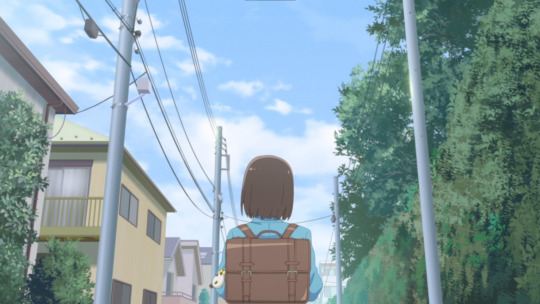
P.A Works and Skip and Loafer are doing it again, and again, and again. They continue to deliver interesting and unique direction and visuals that pile on a delightfully warm sense of comedy and friendship, and is complemented by thoughtful commentary and exploration of the most challenging aspects of being a high schooler. Today, that topic is regrets and expectations.
But who wants to start with the heavy stuff first, I like the cute and fluffy pieces too! Thanks to this episode's direction though, we get a lot of very beautiful scenery. There's a really strong focus that almost separates environment from characters, and lets you soak both up in copious amounts.

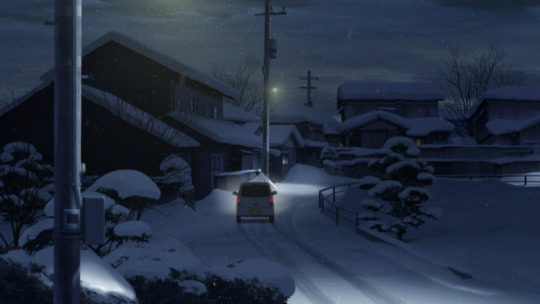



It's just so damn beautiful, but the characters can do a good job of distracting you from it. Take, for example, the use of CGI vehicles in the following scene. Unless you're looking at them they don't do anything other than populate the scenery, they just blend in so well with the lighting and color palette. To that end, I feel like P.A Works' use of CGI throughout the series so far has been really well managed. It fills up the layouts and adds life to the background of it all, but isn't enough where you're forced to look at it.

Anyways, moving on, the overall direction. I like it, it walks a fine line, but I like it. It's an episode that focuses far more on the internal pieces of characters so you get a good few close ups, but they do a good job of molding those pieces so that they fit within a "first person" perspective. It's very hard to explain, but basically the way they frame and block characters within a scene is to have viewers look through the eyes of a character, instead of the lens of a camera. It's a subtle piece, and I feel like they could do it better in some other areas, but there's quite a few pieces that stand out and really sell that first person feel.
Just simple things, like this scene of Mitsumi watching the old TV Drama that Shima-Kun acted in. The FoV is more stretched and there's the slightest visual effects to make sure viewers understand they're looking at a screen.
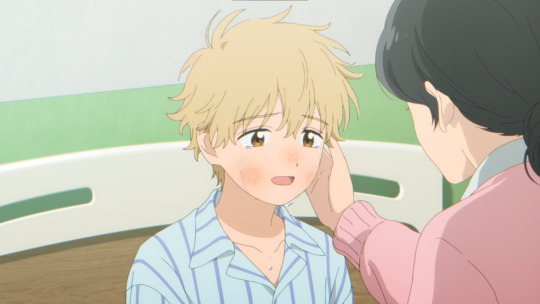
Or scenes like these pairs place us directly behind a character's line of sight (second image is a follow up cut that shows the pair in a single scene).
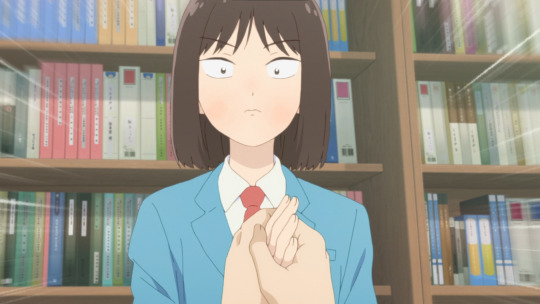



Stuff like this shows the strong awareness of today's episode director. Without these follow-up scenes, the direction (even though the initial scenes are still creative) can come off as typical or "standard", but the concept of that first person perspective is framed by seeing just how you saw the previous scenes. Really great work that's apparent through the episode.
Speaking of apparent through the episode, the comedy! I love that Takamatsu-sensei found a vehicle for their (non-deprecating) humor and ran with it. The adaptability of space, and its relation to Mitsumi is really felt in this episode. Thanks to that, I've got a newfound appreciation for the comedy and the sort of daydreaming aspect. It's so fluid and creative, and no matter what it finds its roots with Mitsumi which is really nice.
And just to round it out, the technical work on the speeds and movement of the background layers in this cut is so well done. Such a great mimicry of how it actually looks.
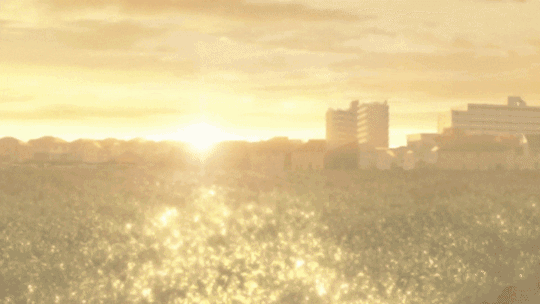
Alright, onto the story now! It's really lovely. I appreciate how it tackles the issues so much. It refuses to look at them as an issue that faces a single character, or one that characters can share, and instead brings the sentiment to a more macro scale and portrays it as something that every high school student deals with.
Shima-Kun has regrets, Mitsumi has regrets, Takamine has regrets, even characters like Kanechika are faced with regret and its challenges. And that's what this episode ends up all about, facing those expectations and staring down regret and what you might regret later down the road.

I feel like the above image really puts the whole episode into context quite well. What does it mean to have no regrets? When will you know if you'll regret something in the moment? They're questions without answers, and the curiosity possessed by the teenagers within the series does well to really sell it.
They don't have a real answer to it, nor can they quite put it into words, but instead they can experience it. They can understand how to live without regrets and how to find happiness in every corner in life. Like this scene of Takamine as she looks out the window of the bus
. She's regretting her decisions, she's beating herself up for losing and wasting time. But one little moment with Mitsumi wipes it all away, because the view was worth it. Such a simple thing as a landscape was enough to ease Takamine, and I think it's great. It's not the big moments that make that difference, it's the little ones you might not otherwise experience.

And god do I love how Takamine and Mitsumi are played off each other. They exist as polar opposites in the most important moments, and show how impactful each is on the other to strike a balance between the two lifestyles. Stuff like Takamine studying while Mitsumi eats candy and watches the scenery go by, just really simple pieces that establish that fundamental rift between the personalities of the two.

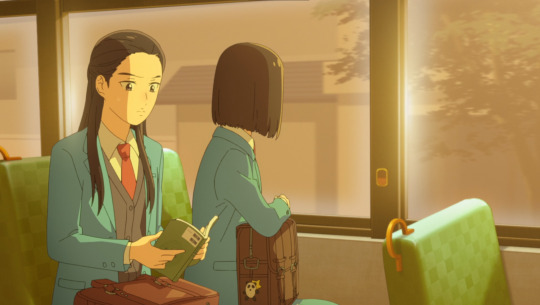
Surprisingly, something this simple is actually an incredibly important piece of symbolism that ties to an earlier conversation that Mitsumi had with Shima-Kun. Mitsumi used to have expectations and regrets weigh incredibly heavy on her, so bad that it was to the point that she wasn't eating while studying for exams. But one person was able to help carry that weight and let Mitsumi be free.
That's what's happening with Takamine and Mitsumi, an implicit conversation telling Takamine that it's okay to betray expectations and have regrets. That you can fail and not get into the middle school of your choice and still have a wonderful life. It's a really wonderful piece for reassuring people with their whole life ahead of them that they have just that. There's no rush to fill your schedule and do everything possible every waking moment to make sure you get to where you're going. It's all about the journey, or in this case, the bus ride.
And just to top it all off, Takamine really changes quite quickly. What's best about it though is that they show it as a subconscious change before they express it as a thought. They used to have nightmares about being left behind by the bus, but that gets replaced with a wonderful little dream sequence that takes Takamine through the stars.

It's just so... good. It does everything right and wonderful and bubbly and cute and sweet. It takes Takamine's desires and feelings as a high school girl and lays them bare to the viewer in what amounts to a fluff sequence.
And why you might ask? Well, like I said earlier it's a subconscious piece of Takamine, so there's lots of things within it. Take the cat, an amalgamation of the cat Mitsumi picked up earlier and Mitsumi herself. And then there's the idea of looking out the window of the bus at the scenery, and within that there's even paralells/similarities to how Takamine saw Mitsumi when she was looking out the bus.
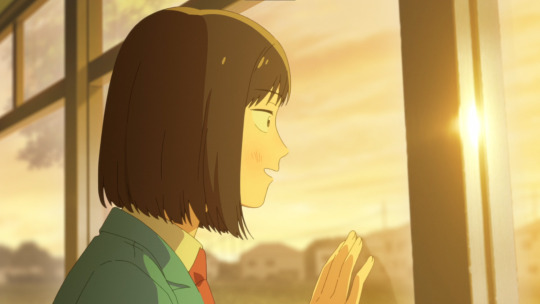

Okay I promise to tie it off here. After her experience in her dream, we see her cutely mistake Mitsumi for the dream cat, before she follows it up with expressing to Mitsumi that she's not the girl that she thinks Mitsumi thinks she is. I think. But yeah, it's a great little scene that shows the confidence Takamine finds in herself from yesterday's experience to face today head on, and create a deeper relationship with Mitsumi in the process.
Even though we're already this far along I feel like there's a world of things to take in. Like how Shima-Kun speaks to expectations and how family bearing down on you can squash happiness and passion as you strive to live up to expectations and earn their affection. Or how thoughtful Mitsumi tries to be at times like not bringing up Shima-Kun's acting career to him. Or how Mitsumi's come to Tokyo to try and change a foundational issue with rural underpopulation in Japan (really, it's a pretty severe issue these days). It's such a diverse and deep story that you can hardly fit all of the good parts into one post. But you can summarize it with a single sentence.
Skip and Loafer continues to prove that it has incredible understanding and nuance in regards to high school life and how it affects students, depicting a wonderfully romanticized story that continues to stay close to the ground and provide important commentary and messages to viewers.
Though I guess that's more like a paragraph, isn't it?
#skip and loafer#skip to loafer#スキップとローファー#iwakura mitsumi#mitsumi iwakura#sousuke shima#shima sousuke#tokiko takamine#anime recommendation#anime review#anime and manga#anime#romcom anime
26 notes
·
View notes
Text
hear me out here also: humans are literally ALIENS in tyria transplanted there by the gods, presumably originating from some sort of unknown Other realm, which means that humans are not part of tyria’s evolutionary history (at the very least not until only ~2116 years ago in tyria)
the native sentient races including asura, charr, and norn would have had their own entirely unique evolutionary trees/histories and bizarre extinct relatives like tyrian equivalents of neanderthals etc etc ((not incl sylvari as they came into existence in a really Weird way and didn’t evolve their humanoid shapes but rather use a form of mimicry to attain them; they don’t have typical genetics/evolution altho they would have weird dragon minion based biology))
which means quite literally anything could have happened across those evolutionary lines and their biology could differ from humans in all sorts of WILD ways and they could have all sorts of unique vestigial traits... even norn who are extremely similar to humans in appearance are completely evolutionarily, genetically, internally, etc different from humans and would have their own really wild history as to how they reached a humanoid appearance plus adaptations that humans don’t have at all
what im saying is honestly tyrian is literally an alien planet, we’re shooting darts at xenobiology here, go fucking ham with your weird headcanons
#what im also saying is that asura are literally ALIEN MONSTERS and i will TREAT THEM AS SUCH idc what anet says about them having --#-- human like reproductive traits. anet is wrong. im the chief writer for asura now
50 notes
·
View notes
Note
I’m trying to come up with quirks based off of Japanese Yokai. I really like the Yamabiko and Betobetosan but I can’t come up with anything good. Got any ideas?
Unfortunately, I couldn't find much information about the Yamabiko, and what little there is does not offer up any sort of unique ability that you could make a Quirk out of. All it can really do is make a weird sound with its mouth, which isn’t really a power. Maybe you could stretch that Sound Mimicry, but that seems like a weak connection at best, like what I did with "Reverb”. And apparently I kind of looks like a weird dog, but that doesn't really seem unique enough to make a connection.
As for the Betobetosan, the only thing that comes to mind is some form of invisibility. Since it's only something you hear and cannot see, having the user be invisible plays into that idea of only being able to hear it’s footsteps right behind you as you are walking.. But I think the issue here is that you are trying to adapt relatively unknown Yokai; ones whose abilities aren't fleshed out or have any comparison to. I think that you should try with some more well know Yokai like the kitsune or tanuki, as there is bound to be a lot of information out about them to base a Quirk off of.
9 notes
·
View notes